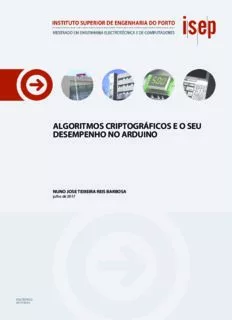
algoritmos criptográficos e o seu desempenho no arduino PDF
Preview algoritmos criptográficos e o seu desempenho no arduino
ALGORITMOS CRIPTOGRÁFICOS E O SEU DESEMPENHO NO ARDUINO NUNO JOSE TEIXEIRA REIS BARBOSA julho de 2017 ALGORITMOS CRIPTOGRÁFICOS E O A SEU DESEMPENHO NO RDUINO Nuno José Teixeira Reis Barbosa Departamento de Engenharia Electrotécnica Mestrado em Engenharia Electrotécnica e de Computadores Área de Especialização em Telecomunicações 2017 Relatório elaborado para satisfação parcial dos requisitos da Unidade Curricular de Tese/Dissertação do Mestrado em Engenharia Electrotécnica e de Computadores Candidato: Nuno José Teixeira Reis Barbosa, Nº 1130203, [email protected] Orientação: Paula Maria Marques Moura Gomes Viana, [email protected] Departamento de Engenharia Electrotécnica Mestrado em Engenharia Electrotécnica e de Computadores Área de Especialização em Telecomunicações 2017 Resumo O Arduino é uma plataforma muito robusta e multifacetada utilizada em diversas situações e, cada vez mais, um elemento relevante na arquitetura da Internet das Coisas. Ao disponibilizar várias interfaces de comunicação sem fios, pode ser utilizado para controlar eletrodomésticos, portas, sensores de temperatura, etc. permitindo implementar facilmente a comunicação entre estas “coisas”. Nesta tese foram estudadas as principais redes sem fios utilizadas pelo Arduino (Bluetooth Low Energy [BLE], Wi-Fi e ZigBee) para tentar perceber qual a que tem o melhor desempenho, vantagens e desvantagens de cada uma, quais os módulos necessários para permitir ao Arduino utilizar esse tipo de rede sem fios, quais as principais funções para que foram projetadas quando criadas e qual o sistema de segurança utilizado nestas redes. Estas diferentes tecnologias sem fios permitem uma maior mobilidade e uma maior flexibilidade no desenho das estruturas de rede do que as redes com fios convencionais. Porém, este tipo de redes têm uma grande desvantagem já que qualquer um dentro do alcance da rede sem fios consegue intercetar o sinal que está a ser transmitido. Para solucionar e proteger a informação que é transmitida por estas redes foram desenvolvidos vários algoritmos de criptografia. Estes dados encriptados só podem ser lidos por dispositivos que tenham uma determinada chave. Os algoritmos de criptografia Data Encryption Standard (DES), Triple DES (TDES), Advanced Encryption Standard (AES), eXtended TEA (XTEA) e Corrected Block TEA (XXTEA) estão entre as técnicas mais conhecidos e usadas atualmente. Nesta tese foram analisados estes algoritmos e as suas vulnerabilidades, tendo também sido feito um levantamento dos principais ataques existentes para avaliar se ainda são seguros atualmente. De forma a avaliar a possibilidade de utilizar o Arduino em aplicações que utilizem comunicações sem fios com segurança, foram realizados testes de desempenho com os algoritmos de criptografia estudados, usando bibliotecas já existentes. Nos testes de desempenho implementados verificou-se que o AES é bastante mais rápido do que as outras i soluções, oferecendo ainda uma maior segurança. Já o TDES verificou-se ser bastante lento, justificando o porquê de o algoritmo ser pouco usado, sendo ao longo dos anos substituído pelo AES. O XXTEA ficou em posição intermédia no teste de desempenho, tendo uma relação segurança/desempenho interessante e revelando-se assim uma escolha melhor do que o TDES. Palavras-Chave AES, Arduino, Bluetooth, Criptografia, DES, Desencriptação, Encriptação, Internet das Coisas, segurança, TDES, TEA, Wi-Fi, XTEA, XXTEA, ZigBee. ii Abstract The Arduino is a very robust and multifaceted platform used in many situations and, increasingly, a relevant element in the Internet of Things. By providing several wireless communication interfaces, it can be used to control household appliances, doors, temperature sensors, etc. Allowing easy implementation of communication between these "things". In this thesis the main wireless networks used by Arduino (Bluetooth Low Energy [BLE], Wi-Fi and ZigBee) were studied to try to understand which one has the best performance, the advantages and disadvantages of each one, the modules needed to implement each wireless network and what security system are used. These different wireless technologies allow for greater mobility and greater flexibility in the design of network structures than conventional wired networks. However, such networks have a major disadvantage since anyone within the range of the wireless network can intercept the signal being transmitted. Several cryptographic algorithms have been developed to solve and protect the information that is transmitted by these networks. This encrypted data can only be read by devices that have a certain key. Triple Encryption Standard (DES), Advanced Encryption Standard (AES), eXtended TEA (XTEA) and Corrected Block TEA (XXTEA) encryption algorithms are among the best known and currently used algorithms. In this thesis these algorithms have been analyzed to compare their vulnerabilities and to identify the main existing attacks. In order to evaluate the possibility of using Arduino in applications that use wireless communications with security, performance tests were implemented using existing libraries. The results show that the AES is much faster than the other algorithms, offering even greater security. TDES was found to be quite slow, justifying why the algorithm has little used, and why over the years has been replaced by AES. The XXTEA was ranked in the middle of the performance test, having an interesting safety/performance ratio proving it to be a better choice than TDES. iii Keywords AES, Arduino, Bluetooth, DES, Decryption, Encryption, Internet of Things, security, TDES, TEA, Wi-Fi, XTEA, XXTEA, ZigBee. iv Índice RESUMO .....................................................................................................................................................I ABSTRACT ............................................................................................................................................. III ÍNDICE ...................................................................................................................................................... V ÍNDICE DE FIGURAS .......................................................................................................................... VII ÍNDICE DE TABELAS ........................................................................................................................... IX ACRÓNIMOS ........................................................................................................................................... XI 1. INTRODUÇÃO .................................................................................................................................. 1 1.1.OBJETIVOS .......................................................................................................................................... 2 1.2.ORGANIZAÇÃO DO RELATÓRIO ........................................................................................................... 3 2. CRIPTOGRAFIA .............................................................................................................................. 4 2.1.HISTÓRIA ............................................................................................................................................ 5 2.2.DATA ENCRYPTION STANDARD (DES) ................................................................................................... 7 2.3.TRIPLE DATA ENCRYPTION STANDARD (TDES)................................................................................... 27 2.4.ADVANCED ENCRYPTION STANDARD (AES) ........................................................................................ 30 2.5.TINY ENCRYPTION ALGORITHM (TEA)................................................................................................ 49 2.6.EXTENDED TEA (XTEA) .................................................................................................................. 55 2.7.CORRECTED BLOCK TEA (XXTEA) .................................................................................................. 59 3. DESEMPENHO DAS CIFRAS NO ARDUINO ........................................................................... 62 3.1.DESCRIÇÃO DO ARDUINO ................................................................................................................. 63 3.2.ARDUINO IDE ................................................................................................................................... 66 3.3.BIBLIOTECAS .................................................................................................................................... 67 3.4.A FUNÇÃO MICROS() .......................................................................................................................... 69 3.5. AES ................................................................................................................................................ 69 3.6.DES E TDES .................................................................................................................................... 71 3.7.XTEA ............................................................................................................................................... 72 3.8.XXTEA ............................................................................................................................................ 73 3.9.COMPARAÇÃO DIRETA DOS ALGORITMOS TESTADOS ........................................................................ 74 3.10.APLICAÇÕES PARA OS ALGORITMOS ................................................................................................ 76 4. PROTOCOLOS DE COMUNICAÇÃO SEM FIOS DO ARDUINO.......................................... 78 4.1.WI-FI ................................................................................................................................................ 79 v
Description: